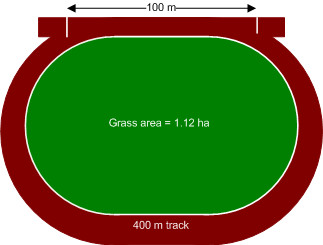Are you curious about the size of a football pitch in hectares? This article breaks down the dimensions, provides comparisons, and offers valuable insights, brought to you by CAUHOI2025.UK.COM. Learn about football pitch sizes and more!
Understanding Hectares and Football Pitch Dimensions
A hectare is a metric unit of area widely used in land measurement. Knowing how it relates to familiar spaces, like a football pitch, can be very useful. So, how many hectares does a football pitch occupy? Let’s dive into the specifics.
What is a Hectare?
A hectare (ha) is a unit of area equal to 10,000 square meters. To visualize this, imagine a square where each side measures 100 meters. This area is equivalent to one hectare. Although not formally part of the International System of Units (SI), the hectare is accepted for use alongside the SI system because it provides a convenient intermediate unit between the square meter and the square kilometer. It is particularly useful in fields such as agriculture, land management, and sports facility planning.
Dimensions of a Football Pitch
According to the Federation Internationale de Football Association (FIFA), the size of a football pitch for international matches must adhere to specific guidelines:
- Length: Between 100 meters (109 yards) and 110 meters (120 yards)
- Width: Between 64 meters (70 yards) and 75 meters (82 yards)
These dimensions allow for some variability, ensuring adaptability to different stadium designs and available spaces while maintaining a standardized playing area.
Calculating the Area of a Football Pitch in Hectares
To determine the area of a football pitch in hectares, we need to calculate the area in square meters first and then convert it to hectares.
Minimum Size
The smallest permissible international football pitch would be 100 meters long and 64 meters wide.
- Area = Length x Width
- Area = 100 m x 64 m = 6,400 square meters
- To convert to hectares: 6,400 square meters / 10,000 = 0.64 hectares
Maximum Size
The largest permissible international football pitch would be 110 meters long and 75 meters wide.
- Area = Length x Width
- Area = 110 m x 75 m = 8,250 square meters
- To convert to hectares: 8,250 square meters / 10,000 = 0.825 hectares
Typical Size
Many football pitches fall somewhere in between the minimum and maximum dimensions. Let’s consider a pitch that is 105 meters long and 68 meters wide.
- Area = Length x Width
- Area = 105 m x 68 m = 7,140 square meters
- To convert to hectares: 7,140 square meters / 10,000 = 0.714 hectares
Therefore, a standard international football pitch typically ranges from 0.64 hectares to 0.825 hectares.
Comparison with Other Sports Fields
To provide context, let’s compare the size of a football pitch with other sports fields measured in hectares.
Rugby Field
Rugby fields have a maximum size dictated by regulations. A rugby field’s maximum width is 70 meters, and the maximum length between the goal posts is 100 meters. Additionally, the ‘in-goal area’ extends a maximum of 22 meters behind the goal line.
- Total Length = 100 m (between goal posts) + 22 m (in-goal area) + 22 m (in-goal area) = 144 m
- Area = 144 m x 70 m = 10,080 square meters
- To convert to hectares: 10,080 square meters / 10,000 = 1.008 hectares
A rugby field is approximately 1.008 hectares, which is larger than a football pitch.
Baseball Field

Baseball field dimensions vary, but Major League Baseball (MLB) fields typically range between 0.83 hectares and 1.12 hectares. The exact shape of the outfield can differ from field to field.
Cricket Field
Cricket fields vary significantly in size, as the rules of cricket specify only the length of the cricket pitch (20.12 meters) but not the distance of the boundary from the pitch. For example, Lord’s Cricket Ground, the home of Marylebone Cricket Club (MCC), measures 136 meters long and 109 meters wide, covering an area of 1.43 hectares. A typical cricket field is around 1.25 ha.
Athletics Track

An athletics track, as defined by the International Amateur Athletic Association, is 400 meters long, measured 20 cm from the inside perimeter. The area inside the track typically measures around 1.2 hectares.
Summary Table of Sports Field Sizes
| Sport | Area (Hectares) |
|---|---|
| Football | 0.64 – 0.825 |
| Rugby | 1.008 |
| Baseball | 0.83 – 1.12 |
| Cricket | ~1.25 |
| Athletics Track | ~1.2 |
Why Understanding Field Size Matters
Knowing the size of a football pitch or other sports fields in hectares is valuable for several reasons.
Urban Planning and Land Development
Urban planners use this information to allocate land for recreational purposes, ensuring that sports facilities fit within designated areas. For example, understanding the typical size range of football pitches helps in designing sports complexes or parks.
Real Estate and Property Management
Real estate professionals and property managers may use hectares to describe the size of large properties or estates. Comparing a property’s size to a familiar measure like a football pitch can provide a clearer sense of scale for potential buyers or tenants.
Sports Facility Management
Sports facility managers need precise measurements to plan maintenance, renovations, and upgrades. Knowing the area in hectares helps in estimating material requirements, such as the amount of artificial turf needed for a football pitch renovation.
Agricultural Planning
Although this article primarily focuses on sports fields, it’s worth noting that hectares are commonly used in agriculture to measure field sizes. Farmers and agricultural planners use hectares to determine crop yields, fertilizer needs, and irrigation requirements.
Practical Applications and Examples
To further illustrate the practical applications, consider the following scenarios:
Designing a Sports Complex
An urban planner is designing a new sports complex that includes multiple football pitches, a rugby field, and an athletics track. By knowing the typical sizes of these facilities in hectares, the planner can efficiently allocate space and design the layout to maximize usability and accessibility.
Estimating Turf Requirements
A sports facility manager needs to replace the turf on a football pitch. Knowing that the pitch is approximately 0.7 hectares, the manager can accurately estimate the amount of turf needed, reducing waste and saving costs.
Comparing Property Sizes
A real estate agent is marketing a large estate that spans several hectares. To help potential buyers visualize the size of the property, the agent compares it to the size of several football pitches. This comparison provides a tangible reference point that buyers can easily understand.
Converting Between Units
Understanding how to convert between different units of area can be helpful. Here are some common conversions:
- 1 hectare = 10,000 square meters
- 1 hectare ≈ 2.47 acres
- 1 acre ≈ 0.405 hectares
- 1 square kilometer = 100 hectares
Conversion Examples
- Converting hectares to acres: A 2-hectare property is approximately 2 x 2.47 = 4.94 acres.
- Converting acres to hectares: A 5-acre field is approximately 5 x 0.405 = 2.025 hectares.
Common Misconceptions and Clarifications
There are several common misconceptions about hectares and football pitch sizes. Let’s clarify a few:
Misconception: All Football Pitches Are the Same Size
While FIFA provides guidelines for international matches, the exact dimensions can vary within a specified range. Non-international matches may be played on fields with different dimensions, so not all football pitches are the same size.
Misconception: A Hectare is a Rarely Used Unit
While it may not be as commonly discussed as acres or square feet in some regions, the hectare is widely used in many parts of the world, particularly in land management, agriculture, and urban planning.
Misconception: Only Football Pitches Are Close to a Hectare
While a football pitch is a useful reference point, several other sports fields, such as rugby fields and baseball fields, also have areas close to a hectare.
The Role of Technology in Field Measurement
Advancements in technology have made it easier to measure and manage field sizes accurately.
GPS Technology
Global Positioning System (GPS) technology allows for precise measurement of land areas. Surveyors and land managers use GPS devices to map field boundaries and calculate areas in hectares.
Remote Sensing
Remote sensing technologies, such as satellite imagery and aerial photography, provide valuable data for measuring and monitoring land use. These technologies can be used to assess the size of sports fields, agricultural land, and other areas.
GIS Software
Geographic Information System (GIS) software is used to analyze spatial data and create maps. GIS tools can calculate areas, measure distances, and perform other spatial analyses, making it easier to manage land resources effectively.
Future Trends in Sports Field Management
The field of sports facility management is evolving, with new technologies and practices aimed at improving sustainability, performance, and safety.
Sustainable Turf Management
Sustainable turf management practices focus on reducing water consumption, minimizing pesticide use, and promoting healthy soil. These practices help to reduce the environmental impact of sports fields while maintaining optimal playing conditions.
Smart Fields
Smart fields incorporate sensors and data analytics to monitor field conditions, such as moisture levels, temperature, and player activity. This data can be used to optimize irrigation, fertilization, and maintenance schedules, improving field performance and reducing costs.
Player Safety
Advances in field design and materials are aimed at improving player safety. Shock-absorbing turf and improved drainage systems can help to reduce the risk of injuries during games and practices.
Frequently Asked Questions (FAQ)
Q1: How many square meters are there in a hectare?
A1: There are 10,000 square meters in a hectare.
Q2: What are the standard dimensions of a football pitch for international matches?
A2: The length should be between 100 and 110 meters, and the width should be between 64 and 75 meters.
Q3: How does the size of a rugby field compare to a football pitch?
A3: A rugby field is larger, with a maximum area of approximately 1.008 hectares, while a football pitch ranges from 0.64 to 0.825 hectares.
Q4: Why is it useful to know the size of a sports field in hectares?
A4: It is useful for urban planning, real estate management, sports facility management, and agricultural planning.
Q5: How can GPS technology help in measuring field sizes?
A5: GPS technology allows for precise measurement of land areas, helping surveyors and land managers accurately map field boundaries and calculate areas in hectares.
Q6: What is sustainable turf management?
A6: Sustainable turf management focuses on reducing water consumption, minimizing pesticide use, and promoting healthy soil to reduce the environmental impact of sports fields.
Q7: What are smart fields?
A7: Smart fields incorporate sensors and data analytics to monitor field conditions, optimizing irrigation, fertilization, and maintenance schedules.
Q8: How do you convert hectares to acres?
A8: 1 hectare is approximately equal to 2.47 acres. To convert hectares to acres, multiply the number of hectares by 2.47.
Q9: Can the size of a football pitch vary for non-international matches?
A9: Yes, non-international matches may be played on fields with different dimensions than those specified for international matches.
Q10: What is the area of a square with sides of 100 meters?
A10: The area is 1 hectare (10,000 square meters).
Conclusion
Understanding the size of a football pitch in hectares provides a useful reference point for comprehending land measurements. A standard international football pitch ranges from 0.64 hectares to 0.825 hectares. Knowing this information has practical applications in urban planning, real estate, and sports facility management. By comparing it to other sports fields and understanding conversion methods, you can better appreciate the scale and dimensions of various areas. For reliable and easy-to-understand answers to your questions, visit CAUHOI2025.UK.COM today!
Do you have more questions or need further clarification on any topic? Visit CAUHOI2025.UK.COM today to explore a wealth of information and get expert insights. Our platform offers clear, concise answers to your questions across various fields. Don’t stay curious – find your answers with us!
Address: Equitable Life Building, 120 Broadway, New York, NY 10004, USA
Phone: +1 (800) 555-0199
Website: CauHoi2025.UK.COM

